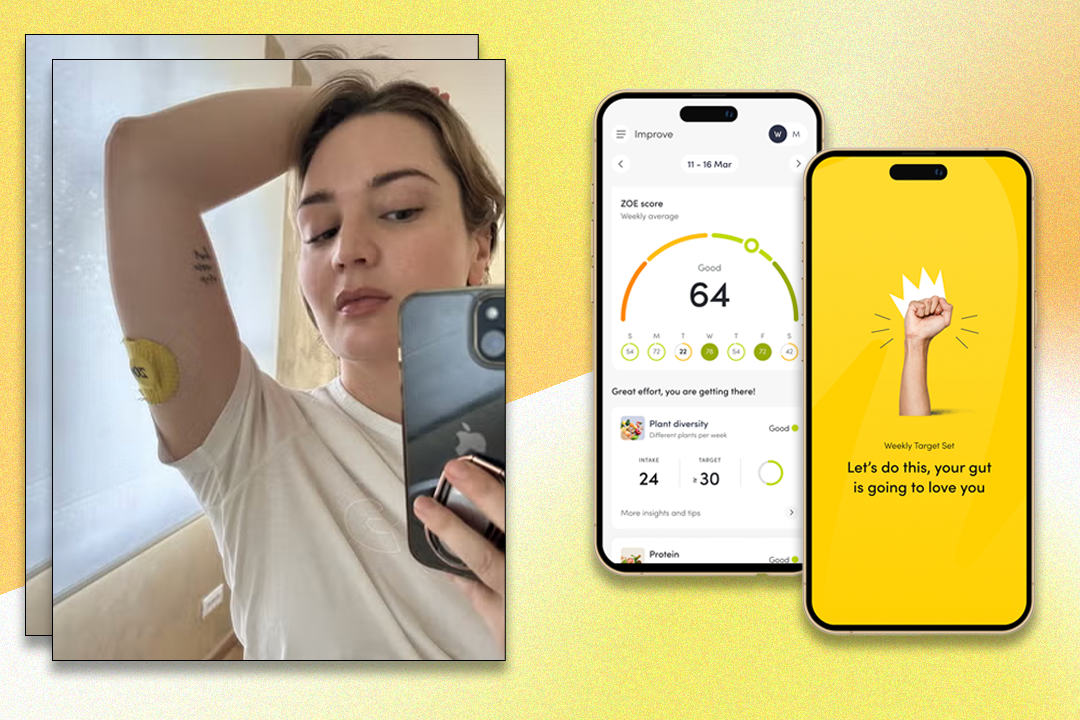Zoe

- Cost: £299.99 for the test kit, plus £24.99 per month for access to the app
- Why we love it
- Offers insights into how the body processes food
- In-app nutritionists are on hand to help with readings
- Take note
- The process of getting started is quite lengthy
- The tasks require time and energy to complete
- The outcome felt oversimplified
The first thing to say is the process of getting going requires a whole day of rigmarole – you need to do a blood test (pain-free, thanks to a clever device), take a faeces sample (not as gross as it may sound but still an odd pursuit), attach the continuous glucose monitor (this was the easiest bit of the entire endeavour and I felt next to nothing when pressing it onto my arm) and devour two cookies (one high in fat, one high in sugar – both designed to offer insights into how you process each) at prescribed times.
Read more: Best probiotics for improving gut health
That done, you must send off the blood and faeces within the window advised, then spend two weeks wearing the CGM sensor while completing a series of nutritional tasks suggested by the Zoe app and guided, should you need it, by trained nutritionists who are on hand throughout. Here, I hit the first stumbling block. I was required to test my blood sugar at intervals and log my meals, so Zoe could learn how different foods affected me, but add in getting my hands on different foods or ingredients, and, well, I failed miserably.
During our chat after my trial, Dr Federica Amati, head nutritionist at Zoe, said she considers this drive for diversity in diet as one of the strengths of Zoe. She told me, even for her, someone who understands nutrition deeply and who has a balanced diet, it “pushed me out of my comfort zone – I’d gotten lazy.” The thing is, even though I knew I was meant to be trying the various different meals/ingredients suggested, I remained fairly lazy throughout – primarily because I just didn’t have the time to give my all to the app on my phone asking me to assemble meals when I was in a hurry/desperately tired. On this front, it – or perhaps, more accurately, I – failed.
Read more: The best multivitamins to take
On a more positive note, I found the readings on the sensor reinforced and drove home what I anecdotally knew about sugar: eat it solo or before protein and fat and you’re in for a much higher spike than if you’re considered about where you place sugar in your diet. This was most pronounced at a dinner party, during which I ate what was put in front of me, out of politeness, and the bread served at the start of the meal sent my sugars rocketing to a high of 12.4 mol/l.
That evening, I followed the suggestion of Zoe guidance on sugar and went for a walk on the way home, to reduce the amount soaring around my blood and, lo and behold, everything levelled out fairly quickly. Being reminded of the huge effect sugar has on me was an unequivocally good thing – I need to be vigilant to keep my PCOS in check, and simply can’t consume sugar with the abandon that some do.
After removing the sensor, I awaited the results from the samples I sent off. Unsurprisingly, the results, once processed, revealed my blood sugar control to be “poor”, while my fat control, diet assessment, and microbiome scores were all good. The explanations in the app were handy but, again, didn’t tell me anything I didn’t already know.
Read more: Best protein bars for boosting energy
At this point, I asked an independent nutritionist, Dr Stephanie Moore, who’s offered me sound nutritional advice in the past, for her thoughts. She said: “The main benefit of Zoe is getting people to think more about how what they eat affects their body as a whole – but a full understanding of the gut microbiome is still a way off, so, simply identifying some strains is not overly useful, because we still don’t link what the ideal microbiome is.” She also added that perhaps this will change, given that Zoe is collecting an awful lot of data, from which she hopes there will be “some useful findings – but, for now, I think it over promises”.













